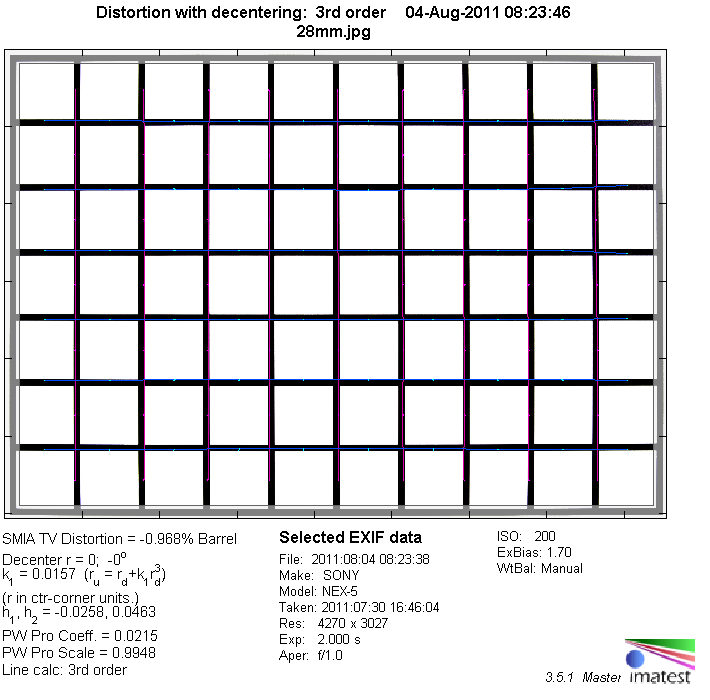|
Zeiss Biogon T* 28mm f/2.8 ZM on Sony NEX - Review / Lab Test Report - Analysis |
|
Lens Reviews -
Sony Alpha/NEX (APS-C)
|
|
Page 2 of 2

Distortion
The Zeiss lens produces a slight amount of barrel distortion (~0.9) which is not relevant from a real world perspective.

Vignetting
The vignetting characteristic of the Biogon is rather unusual. Full format lenses don't tend to have any issues on APS-C cameras but the Zeiss lens struggles quite a bit here. The light fall-off reaches a rather obvious 1.27EV (f-stops) at f/2.8. There's still some vignetting at f/2.8 and it does not improve below 0.6EV at smaller apertures.

MTF (resolution)
The Zeiss ZM lenses are renowned for delivering excellent results on film but the ZM 28mm f/2.8 struggles somewhat with the Sony sensor on the NEX-5. The center performance is just great at all relevant aperture settings. However, the border performance is soft at f/2.8. Stopping down to f/4 lifts the results into good territory and just beyond the very good barrier at f/5.6 and f/8. Diffraction effects have a higher impact from f/11 onwards.
The image corners show a slightly reddish tint which indicates that the light hits the sensor in a less than optimal angle. Possibly an explanation for the comparatively disappointing results when coupled with the Sony sensor rather than film.
Please note that the MTF results are not directly comparable across the different systems!
Below is a simplified summary of the formal findings. The chart shows line widths per picture height (LW/PH) which can be taken as a measure for sharpness.
If you want to know more about the MTF50 figures you may check out the corresponding Imatest Explanations
Chromatic Aberrations (CAs)
Lateral CAs are very well controlled with an average pixel width of around 0.6px at the image borders. This is barely visible in field images.

Verdict
The Zeiss Biogon T* 28mm f/2.8 may be a star on Leica M film cameras but it struggles somewhat with the Sony sensor in the NEX-5. The image quality is pretty much breathtaking in the image center but the border performance is actually much less impressive and in fact quite soft at large aperture settings. The border quality improves to very good levels (just) when stopping down though. There's a bit of a reddish tint in the image corners which suggests a rather "difficult" angle-of-light for the sensor. Lateral CAs are very well controlled. The barrel distortion is barely visible. The vignetting characteristic is less than impressive at f/2.8 and still comparatively high beyond, which is quite surprising for a full format lenses used on an APS-C camera.
The Biogon is a Leica M mount lens which can easily be used via a Leica M to E-mount adapter. Consequently you've to live without AF and an automatic aperture. However, thanks to the EVIL design of Sony NEX cameras (magnified focus view, LiveView) this is less of an issue compared to adapter solutions on DSLRs. The build quality of the Zeiss lens is superb thanks to an all-metal body and super-smooth controls. However, regarding its optical characteristic on the Sony NEX-5 it is not an obvious choice - especially regarding its rather high price tag.
|